湖南师范大学《课程与教学论》课程期末考试试题
- 格式:docx
- 大小:93.48 KB
- 文档页数:1

期末复习提纲一、解释概念课程、课程内容、课程计划、隐性课程、学科课程、综合课程、校本课程、教育方针、课程目标、普遍性目标、行为性目标、教学模式、问题解决模式、自主探究教学模式、研究性教学模式、讲授法、读书指导法、发现学习、程序教学、计算机辅助教学、教学手段、教学组织形式、班级授课制、开放教学、教学评价、形成性评价、质性评价、表现性测验、教学设计、课堂教学管理二、选择题1.下列不属于潜在课程功能的是()。
A.激励功能 B.情感愉悦功能C.个体素质发展功能 D.社会价值观的导向功能2.“指向教育的总体方向,体现的是普遍的、总体的、终极的教育价值”,这是指()。
A.课程与教学目标 B.教育目标C.教育目的 D.培养目标3.教育目标具有层次结构;教育目标要以学生具体的、外显的行为来陈述;教育目标超越了学科内容。
这三个典型特征是属于()。
A.布卢姆等人的“教育目标分类学”的特征B.艾斯纳的表现性目标的特征C.斯腾豪斯等人的生成性目标的特征D.传统的普遍性目标的特征4.以下不属于一般教学目标编写的表达方式的是()。
A.行为目标B.发展目标C.表现目标D. 内部心理与外显行为相结合的目标5.行为目标具有的特点是具体性、可操作性和()。
A.普遍性B.精确性C.规范性D.模糊性6.赫尔巴特提出的教学过程的“形式阶段”包括明了、联合、系统和()。
A.复习B.实践C.方法D.拓展7.“教学设计是一个连续创造的过程,指向于人的解放”,教学设计的这种特征反映的课程实施取向是()。
A.忠实取向B.相互适应取向C.课程创生取向D.实践取向8.()是一种以实际训练为主的教学方法,其主要价值在于形成和发展学生的技能和技巧。
A. 演示法B. 研究法C. 谈话法D. 练习法9.尝试教学法是我国()提出的教学方法改革。
A.卢仲衡B.魏书生C.黎世法D.邱学华10.在非指导性教学中,教师的身份是()。
A.先知者B.管理者C.促进者D.指导者11.()以教师为中心是传统的刻板的教学法,自始至终以教师充当主动的只是专家,而学生扮演着接受者的角色。
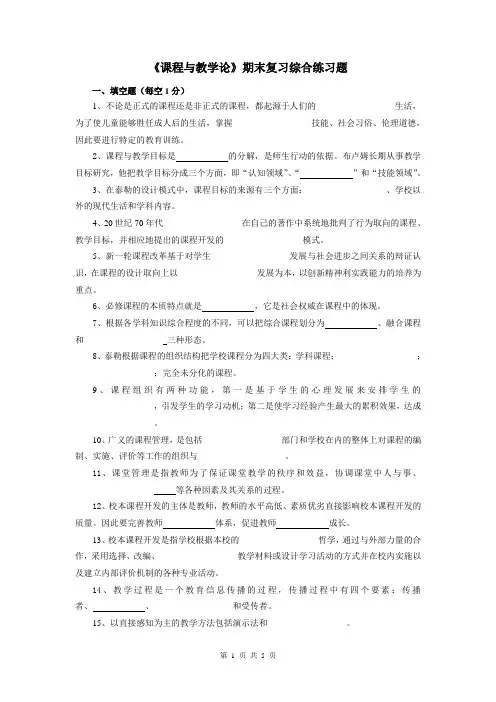
《课程与教学论》期末复习综合练习题一、填空题(每空1分)1、不论是正式的课程还是非正式的课程,都起源于人们的__________________生活,为了使儿童能够胜任成人后的生活,掌握__________________技能、社会习俗、伦理道德,因此要进行特定的教育训练。
2、课程与教学目标是的分解,是师生行动的依据。
布卢姆长期从事教学目标研究,他把教学目标分成三个方面,即“认知领域”、“”和“技能领域”。
3、在泰勒的设计模式中,课程目标的来源有三个方面:__________________、学校以外的现代生活和学科内容。
4、20世纪70年代__________________在自己的著作中系统地批判了行为取向的课程、教学目标,并相应地提出的课程开发的__________________模式。
5、新一轮课程改革基于对学生__________________发展与社会进步之间关系的辩证认识,在课程的设计取向上以__________________发展为本,以创新精神利实践能力的培养为重点。
6、必修课程的本质特点就是,它是社会权威在课程中的体现。
7、根据各学科知识综合程度的不同,可以把综合课程划分为、融合课程和__________________三种形态。
8、泰勒根据课程的组织结构把学校课程分为四大类:学科课程;__________________;__________________;完全未分化的课程。
9、课程组织有两种功能,第一是基于学生的心理发展来安排学生的__________________,引发学生的学习动机;第二是使学习经验产生最大的累积效果,达成__________________。
10、广义的课程管理,是包括__________________部门和学校在内的整体上对课程的编制、实施、评价等工作的组织与__________________。
11、课堂管理是指教师为了保证课堂教学的秩序和效益,协调课堂中人与事、__________________等各种因素及其关系的过程。
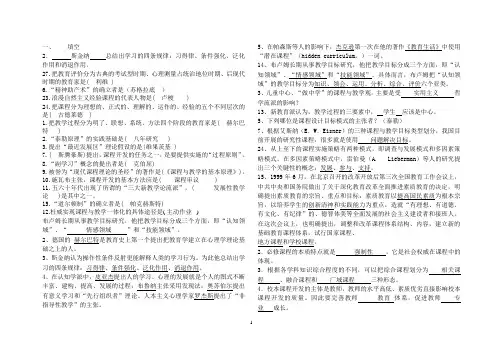
一、填空2.斯金纳总结出学习的四条规律:习得律、条件强化、泛化作用和消退作用。
27.把教育评价分为古典的考试型时期、心理测量占统治地位时期、后现代时期的教育家是( 利维 )6.“精神助产术”的确立者是(苏格拉底)23.浪漫自然主义经验课程的代表人物是( 卢梭 )24.把课程分为理想的、正式的、理解的、运作的、经验的五个不同层次的是( 古德莱德 )1.把教学过程分为明了、联想、系统、方法四个阶段的教育家是( 赫尔巴特 )2.“泰勒原理”的实践基础是( 八年研究 )3.提出“最近发展区”理论假设的是(维果茨基 )7.( 斯腾豪斯)提出,课程开发的任务之一,是要提供实施的“过程原则”。
8.“副学习”概念的提出者是( 克伯屈)9.被誉为“现代课程理论的圣经”的著作是(《课程与教学的基本原理》)。
10.施瓦布主张,课程开发的基本方法应是( 课程审议 )11.五六十年代出现了所谓的“三大新教学论流派”,( 发展性教学论 )是其中之一。
15.“道尔顿制”的确立者是( 帕克赫斯特)12.杜威实现课程与教学一体化的具体途径是( 主动作业)布卢姆长期从事教学目标研究,他把教学目标分成三个方面,即“认知领域”、“情感领域”和“技能领域”。
2、德国的赫尔巴特是教育史上第一个提出把教育学建立在心理学理论基础之上的人。
3、斯金纳认为操作性条件反射更能解释人类的学习行为。
为此他总结出学习的四条规律:习得律、条件强化、泛化作用、消退作用。
4、在认知学派中,皮亚杰提出人的学习、心理的发展就是个人的图式不断丰富、建构、提高、发展的过程;布鲁纳主张采用发现法;奥苏伯尔提出有意义学习和“先行组织者”理论。
人本主义心理学家罗杰斯提出了“非指导性教学”的主张。
5、在帕森斯等人的影响下,杰克逊第一次在他的著作《教育生活》中使用“潜在课程”(hidden curriculum。
)一词。
14、布卢姆长期从事教学目标研究,他把教学目标分成三个方面,即“认知领域”、“情感领域”和“技能领域”。
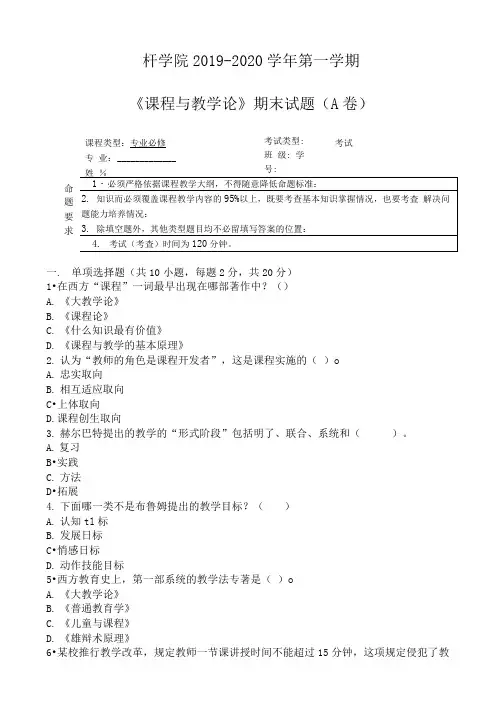
杆学院2019-2020学年第一学期《课程与教学论》期末试题(A 卷)一. 单项选择题(共10小题,每题2分,共20分)1•在西方“课程”一词最早出现在哪部著作中?()A. 《大教学论》B. 《课程论》C. 《什么知识最有价值》D. 《课程与教学的基本原理》2. 认为“教师的角色是课程开发者”,这是课程实施的( )oA. 忠实取向B. 相互适应取向C •上体取向D.课程创生取向3. 赫尔巴特提出的教学的“形式阶段”包括明了、联合、系统和( )。
A. 复习B •实践C. 方法D •拓展4. 下面哪一类不是布鲁姆提出的教学目标?( ) A. 认知tl 标B. 发展日标C •悄感日标D. 动作技能目标5•西方教育史上,第一部系统的教学法专著是( )oA. 《大教学论》B. 《普通教育学》C. 《儿童与课程》D. 《雄辩术原理》6•某校推行教学改革,规定教师一节课讲授时间不能超过15分钟,这项规定侵犯了教 课程类型:专业必修专 业: _____________ 考试类型: 班 级: 学 号: 考试命题 要 求师的()oA.教育教学权B.管理与指导学生权C.评价学生权D.参与学校管理权7•被誉为“现代课程理论之父”的是()oA.博比特B•特斯C.泰勒D•泰罗&“给学生一篇文章,学生在五分钟内不黑帮助或参考书,能够识别出它的风格。
”这种教学目标的表述属于()oA•行为目标B.普遍性13标C•生成性目标D.表现性目标9.课程开发以学科知识及其发展为基点、强调学科知识的优先性,此种课程观是A.儿童中心课程B.社会中心课程C.学科中心课程D.经验中心课程10•根据皮亚杰的道德发展阶段论,当儿童开始有了规则意识,并且认为规则制定属于年长者的专利,这时的儿童处于道德发展的哪一阶段?()A.前道德阶段B.权威阶段C.自律或合作阶段D.公正道德阶段二、多选题(共5小题,每题3分,共15分,多选.错选、少选均不得分)1•关于课程论与教学论的关系,国外的主要观点有()oA.两者相互独立B.两者相互包含C.两者相互交义D.两者循环联系2•课程与教学论的基本任务有()oA.认识课程与教学现象B•解释课程与教学规律C.指导课程与教学实践D.整理课程与教学经验3•倡导综合课程的基本依据是()oA•文化或学科知识的发展不是相互隔离、彼此封闭的,而是相互作用、彼此关联的。
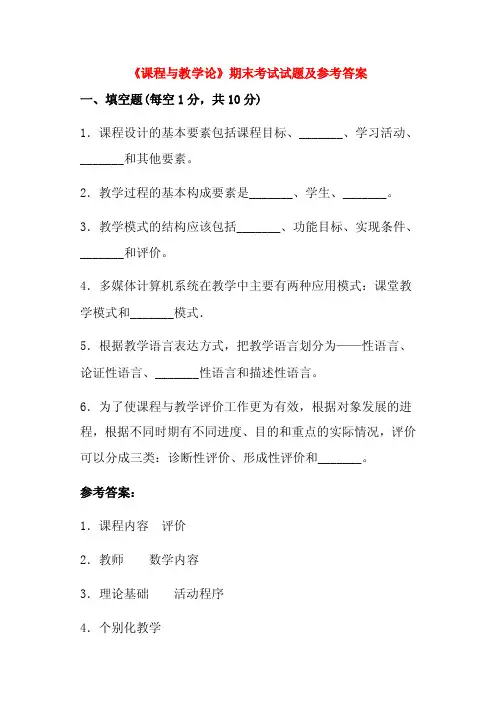
《课程与教学论》期末考试试题及参考答案一、填空题(每空1分,共10分)1.课程设计的基本要素包括课程目标、_______、学习活动、_______和其他要素。
2.教学过程的基本构成要素是_______、学生、_______。
3.教学模式的结构应该包括_______、功能目标、实现条件、_______和评价。
4.多媒体计算机系统在教学中主要有两种应用模式:课堂教学模式和_______模式.5.根据教学语言表达方式,把教学语言划分为——性语言、论证性语言、_______性语言和描述性语言。
6.为了使课程与教学评价工作更为有效,根据对象发展的进程,根据不同时期有不同进度、目的和重点的实际情况,评价可以分成三类:诊断性评价、形成性评价和_______。
参考答案:1.课程内容评价2.教师数学内容3.理论基础活动程序4.个别化教学5.叙述说明6.终结性评价二、判断题(每小题2分,共lo分。
在每小题后面的括号内,根据自己的判断填上“正”或“误’)1.教学过程就是教师教学生学的过程。
( )2.课程内容的选择要考虑内容本身的性质。
( )3.板书的艺术特点之一是要具有示范性。
( )4.学术理性主义取向课程注重教学的内容,强调传统文化的传递与继承,通常以逻辑组织严密的分科课程的面貌出现。
( )5.课程与教学评价的对象主要是对教师的评价.( )参考答案:1.错2.对3.对4.对5.错三、简答题(每小题10分,共40分)1.什么是教学?2.简述情境一陶冶教学模式的内涵。
3:什么是螺旋式课程组织?4.简述课堂教学评价的含义。
参考答案:1.教学:从广义上讲,教学是指教者指导学习者进行的一切有目的的学习活动。
从狭义上讲,教学是指在学校中,教师引导学生进行的学习活动。
2.情境一陶冶教学模式:是指在教学活动中创设一种情感和认知相结合的教学环节,让学生在轻松愉快的教学气氛中获得知识,同时得到情感陶冶的一种教学模式。
3.螺旋式课程组织:是指根据某一学科知识结构的“概念结构”.配合学生的“认知结构”,以促进学生认知能力发展为目的的一种课程发展与设计。
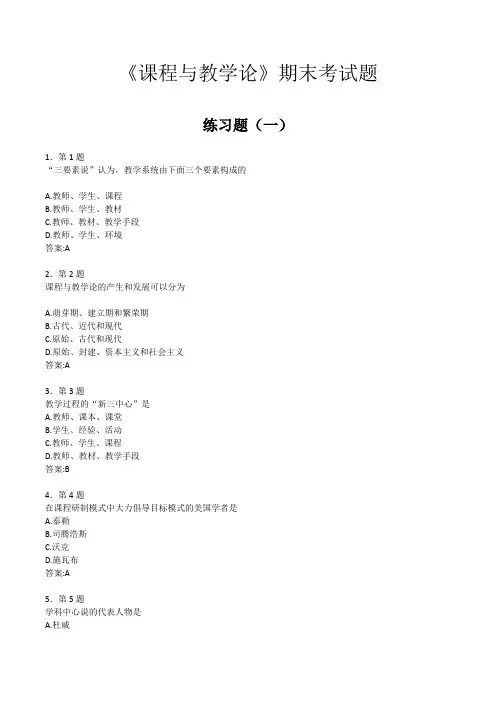
《课程与教学论》期末考试题练习题(一)1.第1题“三要素说”认为,教学系统由下面三个要素构成的A.教师、学生、课程B.教师、学生、教材C.教师、教材、教学手段D.教师、学生、环境答案:A2.第2题课程与教学论的产生和发展可以分为A.萌芽期、建立期和繁荣期B.古代、近代和现代C.原始、古代和现代D.原始、封建、资本主义和社会主义答案:A3.第3题教学过程的“新三中心”是A.教师、课本、课堂B.学生、经验、活动C.教师、学生、课程D.教师、教材、教学手段答案:B4.第4题在课程研制模式中大力倡导目标模式的美国学者是A.泰勒B.司腾浩斯C.沃克D.施瓦布答案:A5.第5题学科中心说的代表人物是A.杜威B.赫尔巴特C.施瓦布D.夸美纽斯答案:C6.第6题下列课程设计模式中,属于问题中心课程设计模式的是A.学科设计B.生活领域设计C.科目设计D.学习者中心设计答案:B7.第7题在某一教学思想和原理的指导下,围绕某一主题,为实现教学目标而形成的相对稳定的规范化教学程序和操作体系就是A.教学内容B.教学模式C.教学形式D.教学方法答案:B8.第15题在学完某门课程或某个重要部分之后进行的旨在评价学生是否已经达到教学目标要求的概括水平较高的测试和成绩评定是A.终结性评价B.形成性评价C.诊断性评价D.相对性评价答案:A9.第16题现代教学的基本组织形式是A.现场教学B.个别教学C.分组教学D.班级授课答案:D10.第17题17世纪,《大教学论》,这本被认为是历史上专门而系统研究和阐述教育问题的专门著作问世,一般人将这本专著的发表看作是教学论诞生的标志。
这本著作的作者是A.昆体良B.夸美纽斯C.裴斯泰洛齐D.赫尔巴特答案:B11.第18题认为课程与教学必须重视学科结构、直觉思维和发现学习的学者是A.杜威B.赫尔巴特C.布鲁纳D.罗杰斯答案:C12.第19题在课程与教学论发展的萌芽时期,产生了一批论述课程与教学问题的专著,其中,世界上已发现的最早的课程与教学论专著是A.《理想国》B.《论语》C.《学记》D.《雄辩术原理》答案:C13.第27题在课程研制中以价值判断和选择为核心的、对理论指导、目标、内容或经验、组织与结构、活动样式或策略、评价等多种可能性和方案进行选择、确定和应用的过程被称为A.课程决策B.课程开发C.课程实施D.课程评价答案:A14.第28题在评价对象群体之外,预定一个客观的或者理想的标准,并运用这个固定的标准去评价每个评价对象的评价类型是A.绝对评价B.相对评价C.他评价D.元评价答案:A15.第29题典型的自学辅导式的教学组织形式是A.班级授课B.个别教学C.道尔顿制D.分组教学答案:C16.第30题“四要素说”认为,构成教学系统的四个要素是A.教师、学生、课程和物质条件B.教师、学生、教材和媒体C.教师、教材、教学手段和目的D.教师、学生、环境和反馈答案:A17.第8题关于课程与教学论的关系问题,西方课程与教学研究领域主要______________、______________、____________和二元循环联系模式等四种不同主张。
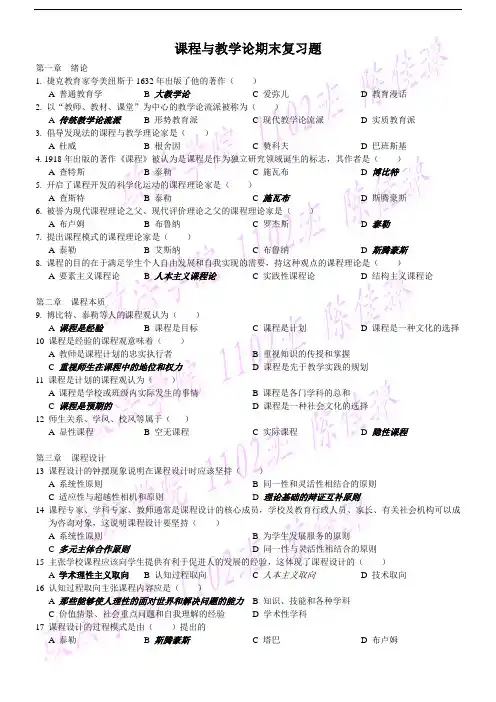
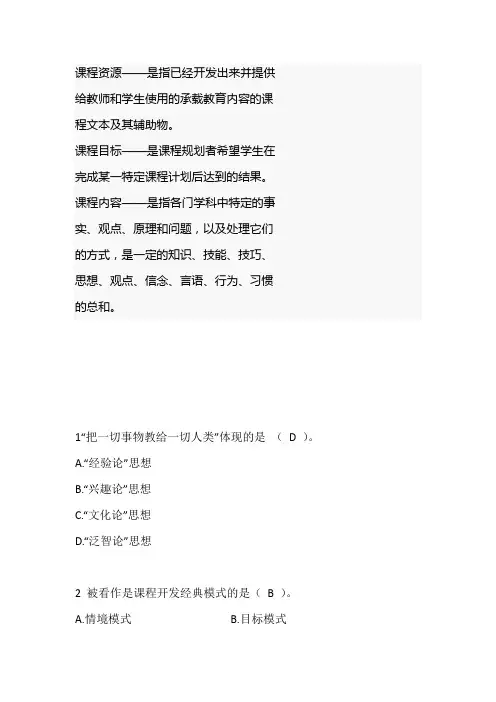
课程资源——是指已经开发出来并提供给教师和学生使用的承载教育内容的课程文本及其辅助物。
课程目标——是课程规划者希望学生在完成某一特定课程计划后达到的结果。
课程内容——是指各门学科中特定的事实、观点、原理和问题,以及处理它们的方式,是一定的知识、技能、技巧、思想、观点、信念、言语、行为、习惯的总和。
1“把一切事物教给一切人类”体现的是(D )。
A.“经验论”思想B.“兴趣论”思想C.“文化论”思想D.“泛智论”思想2 被看作是课程开发经典模式的是(B )。
A.情境模式B.目标模式C.批判模式D.过程模式3 在泰勒看来,课程开发的起点是(A )。
A.确定教育目标B.选择教育经验C.组织教育经验D.评价教育计划4“道尔顿制”的确立者是(C )。
A.巴班斯基B.布卢姆C.帕克赫斯特D.瓦根舍因5“什么知识最有价值”的提出者是(A )。
A.斯宾塞B.吉鲁C.阿普尔D.威利斯6“教学过程是教师与学生以课堂为主渠道的交往过程”,这一命题对师生关系的正确理解是(D )。
A.教师主体学生客体的关系B.学生主体教师客体的关系C.教师主导学生主体的关系D.教师与学生是交互主体的关系7 在非指导性教学中,教师的身份是(C )。
A.先知者B.管理者C.促进者D.指导者8 生成性目标取向追求的是(D )。
A.普遍主义B.唯科学主义C.实践理性D.解放理性9 法国著名思想家卢梭的旷世教育名著是(A )。
A.《爱弥儿》B.《爱的教育》C.《教育漫话》D.《理想国》10 生成性目标是在教育情境之中随着教育过程展开而自然生成的课程与教学目标。
其渊源可以上溯到杜威“教育即生长”的命题以及英国著名课程论专家斯腾豪斯的( B )。
A 目标模式B 过程模式C 实践模式D 解放模式11 被誉为“现代课程理论的圣经”的著作是(C )。
A.课程B.课程编制C.课程与教学的基本原理D.怎样编制课程12 浪漫自然主义经验课程论的代表人物是(B )。
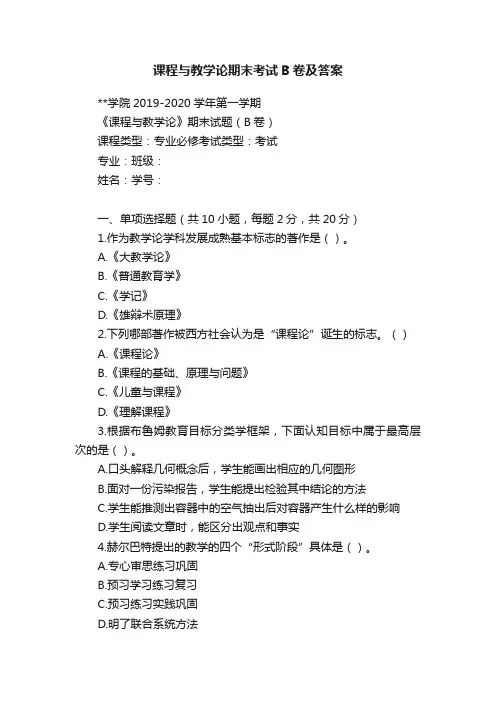
课程与教学论期末考试B卷及答案**学院2019-2020学年第一学期《课程与教学论》期末试题(B卷)课程类型:专业必修考试类型:考试专业:班级:姓名:学号:一、单项选择题(共10小题,每题2分,共20分)1.作为教学论学科发展成熟基本标志的著作是()。
A.《大教学论》B.《普通教育学》C.《学记》D.《雄辩术原理》2.下列哪部著作被西方社会认为是“课程论”诞生的标志。
()A.《课程论》B.《课程的基础、原理与问题》C.《儿童与课程》D.《理解课程》3.根据布鲁姆教育目标分类学框架,下面认知目标中属于最高层次的是()。
A.口头解释几何概念后,学生能画出相应的几何图形B.面对一份污染报告,学生能提出检验其中结论的方法C.学生能推测出容器中的空气抽出后对容器产生什么样的影响D.学生阅读文章时,能区分出观点和事实4.赫尔巴特提出的教学的四个“形式阶段”具体是()。
A.专心审思练习巩固B.预习学习练习复习C.预习练习实践巩固D.明了联合系统方法5.为了使学生加强保护环境的意识,许多学校开设了“环境教育课程”,这种课程属于()。
A.学科本位综合课程B.社会本位综合课程C.儿童本位综合课程D.成人本位综合课程6.师生关系中最基础的关系是()。
A.业务关系B.伦理关系C.情感关系D.管理关系7.现代教学论所说的“三中心”不包括 ( )。
A.活动中心B.经验中心C.社会中心D.儿童中心8.把课程分为理想的、正式的、理解的、运作的、经验的五个不同层次的是( )。
A.古德莱德B.查特斯C.斯金纳D.杜威9.主张由学生自己发现问题、解决问题的教学方法是()。
A.读书指导法B.发现法C.暗示法D.实习法10.“儿童中心主义”教育思想的集大成者是美国教育家()。
A .裴斯泰洛齐B. 卢梭C. 福禄倍尔D. 杜威二、多选题(共5小题,每题3分,共15分,多选、错选、少选均不得分)1.课程与教学关系中,“包含模式”的情形有()。
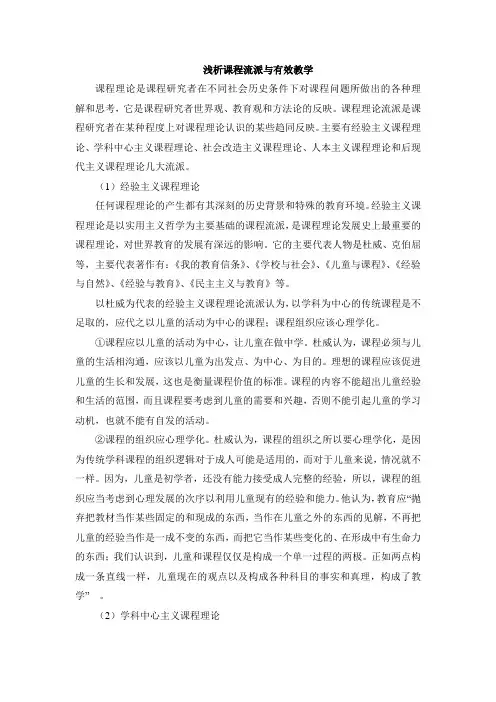
浅析课程流派与有效教学课程理论是课程研究者在不同社会历史条件下对课程问题所做出的各种理解和思考,它是课程研究者世界观、教育观和方法论的反映。
课程理论流派是课程研究者在某种程度上对课程理论认识的某些趋同反映。
主要有经验主义课程理论、学科中心主义课程理论、社会改造主义课程理论、人本主义课程理论和后现代主义课程理论几大流派。
(1)经验主义课程理论任何课程理论的产生都有其深刻的历史背景和特殊的教育环境。
经验主义课程理论是以实用主义哲学为主要基础的课程流派,是课程理论发展史上最重要的课程理论,对世界教育的发展有深远的影响。
它的主要代表人物是杜威、克伯屈等,主要代表著作有:《我的教育信条》、《学校与社会》、《儿童与课程》、《经验与自然》、《经验与教育》、《民主主义与教育》等。
以杜威为代表的经验主义课程理论流派认为,以学科为中心的传统课程是不足取的,应代之以儿童的活动为中心的课程;课程组织应该心理学化。
①课程应以儿童的活动为中心,让儿童在做中学。
杜威认为,课程必须与儿童的生活相沟通,应该以儿童为出发点、为中心、为目的。
理想的课程应该促进儿童的生长和发展,这也是衡量课程价值的标准。
课程的内容不能超出儿童经验和生活的范围,而且课程要考虑到儿童的需要和兴趣,否则不能引起儿童的学习动机,也就不能有自发的活动。
②课程的组织应心理学化。
杜威认为,课程的组织之所以要心理学化,是因为传统学科课程的组织逻辑对于成人可能是适用的,而对于儿童来说,情况就不一样。
因为,儿童是初学者,还没有能力接受成人完整的经验,所以,课程的组织应当考虑到心理发展的次序以利用儿童现有的经验和能力。
他认为,教育应“抛弃把教材当作某些固定的和现成的东西,当作在儿童之外的东西的见解,不再把儿童的经验当作是一成不变的东西,而把它当作某些变化的、在形成中有生命力的东西;我们认识到,儿童和课程仅仅是构成一个单一过程的两极。
正如两点构成一条直线一样,儿童现在的观点以及构成各种科目的事实和真理,构成了教学” 。
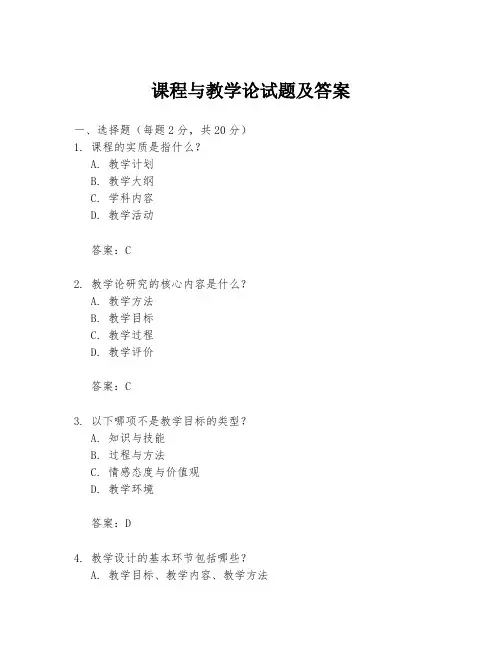
课程与教学论试题及答案一、选择题(每题2分,共20分)1. 课程的实质是指什么?A. 教学计划B. 教学大纲C. 学科内容D. 教学活动答案:C2. 教学论研究的核心内容是什么?A. 教学方法B. 教学目标C. 教学过程D. 教学评价答案:C3. 以下哪项不是教学目标的类型?A. 知识与技能B. 过程与方法C. 情感态度与价值观D. 教学环境答案:D4. 教学设计的基本环节包括哪些?A. 教学目标、教学内容、教学方法B. 教学目标、教学方法、教学评价C. 教学内容、教学方法、教学评价D. 教学目标、教学内容、教学评价答案:B5. 教学评价的主要目的是什么?A. 选拔优秀学生B. 促进学生发展C. 惩罚落后学生D. 增加教学负担答案:B二、填空题(每空1分,共10分)1. 教学过程是教师______、______、______学生学习的过程。
答案:引导、组织、激励2. 教学方法的选用应根据______、______和______来决定。
答案:教学目标、教学内容、学生特点3. 教学评价的类型包括______、______和______。
答案:诊断性评价、形成性评价、总结性评价4. 教学反思是教师对______、______和______的思考和总结。
答案:教学行为、教学效果、教学策略5. 课程资源的开发和利用应遵循______、______和______的原则。
答案:针对性、多样性、有效性三、简答题(每题10分,共20分)1. 简述教学目标的三个维度。
答案:教学目标的三个维度包括知识与技能、过程与方法、情感态度与价值观。
知识与技能是学生通过学习应掌握的基础知识和基本技能;过程与方法是学生在学习过程中应掌握的学习方法和思维方法;情感态度与价值观是学生在学习过程中应形成的积极情感、正确态度和价值观念。
2. 描述教学评价的功能。
答案:教学评价的功能主要包括诊断功能、激励功能、导向功能和反馈功能。
诊断功能是指通过评价了解学生的学习状况,找出问题所在;激励功能是指评价可以激发学生的学习动力和兴趣;导向功能是指评价可以引导学生的学习方向和教师的教学方向;反馈功能是指评价可以为教师和学生提供关于教学效果的反馈信息。
课程与教学论部分Decide whether each of the following statements is true or false. Write a T in the brackets if it is true or an F if it is false. (15 points. 1 point for each other)1.Interaction and experimenting with the language in communication are very important factors for language development. T2.We should not be tolerant to our L2 learners’ errors when they are trying tocommunicate. F3.Children should start learning English as early as possible even if they are not ingood circumstances. F4.Different personalities have different aptitude for learning another language. F5.Motivation and interest in learning are fundamental to ensure success in learning aforeign language for children. T6.Faced with the new curriculum, English teachers are expected to change theirviews about language which is not a means for communication but a system of linguistic knowledge. F7.The new English curriculum is designed to promote the students’overall quality. T8.In order to lay a good foundation for continuing development, more attentionshould be given to the students’language skills, knowledge, affects, strategies and culture awareness. T9. A primary English teacher should be encouraged to use both formative andsummative assessment to evaluate children’s lea rning. T10.Remembering all the International Phonetic Alphabets can automaticallyguarantee good pronunciation. F11.Children learn best when they are involved both physically and mentally. T12.Students need to be given detailed grammar rules if they are to learn a foreignlanguage successfully. F13.Different seating arrangements allow not only different classroom interactions butalso different learner-teacher relationship. T14.As for classroom language, an English teacher should use half Chinese and halfEnglish to make himself or herself understood by the children. F15.A teacher should always speak in a normal voice in English class, for the noisierthe teacher is, the noisier the children will become. F16.A teacher should raise his\her voice above the noise in order to get quiet in theclassroom. F17.A class that is in control is not always quiet and a quiet class with a teacher doingall the talking is not necessarily a good learning environment. T18.Putting summative and formative assessment together, we will be able to form asound basis for checking students’learning and teachers’ teaching. T19.Formative assessment is mainly based on formal testing, which is done mostly atthe end of a learning period or at the end of a school year. F20.By constantly reflecting on teaching and learning, the teacher can move towardsprofessional competence. T21.The method, known as Total Physical Response, means that children respond toteachers’ instructions by using gestures, body language or by speaking loudly. F 22.Children’s attention spa n is very short, thus many long activities are used insteadof short and simple ones. F23.There is no point in explaining complicated grammar rules to children, for theyare not good at analyzing language rules. T24.Children like to do things with difficult learning targets because they want to feelsure that it is not something beyond their ability. F25.One language form may express a number of communicative functions and onecommunicative function cannot be expressed by a variety of language forms. F municative competence entails knowing not only the language code or theform of the language but also knowing how to use the language appropriately in social situations. T27.The English teaching objectives are to develop students overall language abilitieswhich are composed of language knowledge, language skills, affect, learning strategies as well as cross-cultural awareness for relevant levels. T28.It is believed that poor pronunciation may cause problems for the learning of otherskills. T29.Children do not need to learn grammar rules when they acquire their firstlanguage, so they do not need them either when learning a foreign language. F 30.Teaching and learning grammar should focus on practice rather than the study ofgrammar itself. Tnguages consist of “words” with equivalents from one language to another. F32.English-English explanations are the best way for vocabulary teaching. F33.Reading is a silent activity. Reading aloud does not help much withcomprehension. T34.When we read, our eyes should constantly move from letter to letter, word to wordand sentence to sentence. F35.It is helpful to use a dictionary to check and note down the meaning of all the newwords while reading. F36.Possessing a large amount of vocabulary is the key for reading comprehension. F37.It is not necessary to pre-plan the instruction or support the instruction by pictures,demonstrations, or examples. F38.We should expect our students to produce accurate language every time theyspeak. F39.Asking the students to predict or guess the meaning of a word in certain contextbefore explaining it to them is one way to consolidate new words. F40.The main advantage of task-based teaching is that language is used for a genuinepurpose that real communication should take place. T41.Making errors will lead to bad habit formation, so we should correct themwhenever they occur. F42.As a learner of English, you will be forgiven for errors of inappropriateness if youcan speak good English. F43.The English curriculum at the primary phase is designed into 2 levels. Level 1covers Grade 4, Level 2 covers Grade 6. FMultiple choice .Choose from the given choices the correct one and write the corresponding letter in the answer sheet. ( 15points, 1 point for each choice )D 1. Activities can usually “stir ” a class and can also “settle ” it .Which of the following activities is a “stirrer”?A. Ask the whole class to copy a list of food words onto a piece of paper from the board.B. Children open the book and practice the dialogue and ready for an acting out.C. Stick a list of flashcards on the board with number given to each card. Ask thepupils to listen and write down the number of the picture they hear.D. The teacher puts the cards together and takes away one of them and asks thepupils to guess what she has got on her flashcards by saying to the children “guess what I have got on my flashcards”.D 2. Which of the following activities are best done for individual work?A. Story-tellingB. guessing gamesC. information-gap activityD. reading silentlyA 3. Which of the following activities are best done with group work.A. drama performanceB. reading aloudC. writing a letter or e-mailD. presenting new languageC 4. Below is a classroom extract. Which error-correction method is used?A. direct teacher correctionB. whole class correctionC. self-correctionD. peer correctionC 5. The following are things that teachers often do in a language classroom. Decide what role the teacher is playing.A. controllerB. assessorC. prompterD. resource-providerB 6. The following are what teachers often do in a language classroom. Decide what role the teacher is playing.The teacher asks students to produce conversations (either orally or in writing) by using particular patterns or expressions they have just learned.A. assessorB. controllerC. prompterD. participantD 7. The following are what teachers often do in a language classroom. Decide what role the teacher is playing.While doing a writing task either individually or in groups, the students need to use a particular word they don’t know. So they ask the teacher.A. assessorB. prompterC. organiserD. resource-providerA 8. Which of the following activities is best for whole class work ?A. summarizing learningB. performing an information-gap taskC. writing a letter or e-mailD. reading silentlyB 9. Which measure is the most appropriate for the teacher to take if the class seem to be getting out of control, or if discipline occurs due to inappropriacy of the activity?A. stopping the classB. changing the activityC. shouting loudlyD. dealing with it immediatelyD 10. Which of the following ways to solve disciplines problems have proved not useful or effective except ______?A. using threats and shouting loudlyB. giving written homeworkC. putting them in the corridorD. creating a code of behaviorC 11. To develop the skill of listening for gist, which of the following activity should not be included?A. deciding upon a titleB. sequencing the main pointsC. filling in some blanks with the words in the textD. writing a brief summaryB 12. Many proponents of the Communicative Approach advocate the use of ______materials in the language classroom.A. classicB. authenticC. modernD. oralD 13. Single out the statement that can not be classified into the category of thelanguage skills.A. Automatic decoding skillsB. Sufficient amount of vocabularyC. Adequate knowledge of grammarD. Relevant backgroundB 14. Please identify the follow ing students’ reading approach.The reading approach used by Tom is _____.A. top-down approachB. the bottom-up approachC. the interactive approachD. the elective approachC 15. For the production stage in teaching, there is _____.A. no information gap activitiesB .no role play activitiesC. an emphasis on fluency and useD. an emphasis on correctnessA 16. According to the PPP model, which speaking activity in the following wouldmost probably appear at the production stage of the oral class teaching?A. DiscussionB. RepetitionC. Gapped dialogueD. Reading and actingA 17. Which of the following is characteristic of children in learning a foreignlanguage?A. They pay more attention to meaning than to formB. They have a clear purpose in learning a foreign languageC. They can monitor their own learning.D. They can concentrate for a long time in classA 18. Which of the following activities are best done with pair work?A. Information gapB. Guessing gameC. Watching videosD. Role-playD 19. Which of the following helps assess language performances?A. Asking students to reflect on what activities attract them most.B. Asking students about their attitudes towards a certain game.C. Asking students to draw pictures according to description.D. Asking students to do a quiz at the end of the lesson.C 20. Which of the following is suitable for speaking?A. TPR actionsB. Recognizing picturesC. Information gap D .Matching pictures with descriptionsC 21 In which stage of the presentation – practice - production approach will studentshave the chance to use the new language freely and incorporate it into their existing language?A. Presentation stageB. Practice stageC. Production stageD. Presentation and practice stageC 22. What role does a teacher take to create an environment in which learning can take place ?A. InstructorB. PrompterC. ManagerD. AssessorC 23. The following principles except ______ are used for designing activities used in the primary classroom.A. Children learn best when feeling happy and secure.B. Children learn best when they are involved both physically and mentally.C. Children don’t need plenty of opportunities to use similar language again andagain.D. Children learn the whole language rather than through analyzing languagerules.D 24. Mentally-engaged activities require children to think hard while doing them.Which of the following activities belongs to it?A. Reading aloudB. Coping or colouringC. Repeating the sentenceD. Guessing gamesA 25. What is the teacher doing by saying "Now you are going to do this in pairs."?A. Setting up tasks.B. Controlling discipline.C. Demonstrating.D. Getting feedback.A 26. Which role does the teacher play in the following activities?When the students are doing a group-work task, the teacher joins one or two groups for a short period of time.C.participant B. assessorC. source of helpD. controllerB 27. In the process of the PPP model teaching, the amount of the teacher’s controlis expected to ______ as the activities progress from accuracy-focused tofluency-focused.A. increaseB. decreaseC. remainD. loseD 28. What strategy does the following activity help to train reading?Locating the specific information.A. skimmingB. inferringC. word-guessingD. scanningC 29. Which reading skill is the teacher using in reading?The teacher asks the students to try to guess information or ideas that go beyond the literal meaning of the text.B.recognizing organization of the text B. predictingC. inferring or reading between the linesD. scanningA 30. To memorize vocabulary by reading and repeating aloud is______ than to memorize them in context.A. less effectiveB. more effectiveC. much easierD. much quickerC 31. Which of the following can train listening?A. Sequencing the pictures.B. Writing captions for pictures.C. TPR= Total Physical ResponseD. Matching titles with different paragraphs.B 32.The reading approach used by Tom is ______ .A. a bottom-up approachB. a top-down approachC. an eclectic approachD. an interactive approachD 33. What approach is based on the study of texts in the target language, which has to be explained in the mother tongue and then translated?A. the communicative approachB. the humanistic approachC. the functional-notional approachD. the grammar-translation methodC 34. When we read newspapers and magazines, specialized articles, teaching materials, dictionaries, what kind of purpose are we having for reading?A. Reading for survivalB. Reading for entertainmentC. Reading for learning and informationD. Reading for pleasureC 35. What role does the teacher play in the deductive presentation of grammar?A. ParticipantB. PrompterC. InstructorD. AssessorD 36. Which of the following grammar instruction is inductive?A. Explain the structure and usage of passive voice to the students.B. Ask students to read grammar books and tell the rules of passive voice in class.C. Let students practice applying the rule to produce sentences with given prompts.D. Ask students to read the passage and find out the rules for passive voice.A 37. In the classroom, we should try to design authentic communicative activities. The following activities except ______ are all communicative activities.A. drilling exercisesB. information gap activitiesC. role-play activitiesD. mini-research and questionnairesCase analysisThe Lead-in skills of English teaching play an important role in improving the teaching results. Please examine the problem with the following Lead-in part and help the teacher to find the problem, then improve it.Teaching contents: HobbiesJane: What are your hobbies, Lily?Lily: Well, I like music and painting. What about you?Jane: I like music, too. And I also like collecting stamps.Lily: How interesting! Jim likes collecting coins. Do you know that?Jane: Really?Lily: Yes, we can collect a lot of other things.Lead in:1.Sing the song “We are happy bees.”2.Free talkT: Are you happy now, boys and girls?Ss: (学生一时不知怎么回答,有的说Y es, 有的说No,教师尴尬地笑了笑) T: I’ve got some presents for you. They’re in the box. Can you guess what’s in the box?S1: Perhaps it’s a cake.Ss: Biscuits/ Sweets? Flowers… . (学生七嘴八舌、漫无边际地猜想)T: (打开盒子) Look, some chocolate. I’ll give you some chocolate after class.T: Hello, do you like playing basketball?Ss: (学生又是一愣)Y es.(接着老师便呈现新课)Case analysis2.Please examine the problem with the following speaking instructions and help the teacher to find the problem, then improve the instructions.In an oral class, a teacher asks students to answer questions. To ensure smooth progress of his lesson, he always asks the excellent students to answer questions.Case analysis3.There are different ways and techniques for correcting errors. The following is an example that a teacher is trying to correct the students’errors. Are you in favour of the way? Please give your opinions.T: Can you tell us something about your father, Tom?S: My father is 40 years old. He is very high. He is a doctor. He works in our City Hospital.T: Oh, good. V ery good, Tom. Y ou said your father is very high? What word can we use instead of High?S: Y es, Tall. He is tall.T: Wonderful, Tom.Case analysis4. Teaching objective is one of the basic components that a lesson should have. Please examine the problem with the following teaching objectives and help the teacher to find the problem, then improve them.Teaching contents: The first period of Unit 2 Public Signs from Oxford Primary English. The text is about learning some public signs such as “Keep quiet!” , “Keep off the grass!”, “Danger” etc.Teaching objectives:1.To learn the new words: always, must, away, should, cage, noise ….2.To learn the sentence pattern:1) It means we ….2) Y ou must/ should/ shouldn’t ….。
《课程与教学论》2019期末试题及答案
一、填空(每空l分。
共10分)
1.课程资源是教学内容的直接来源,它包括和,
2.课程设计的基本要素包括课程目标、、学习活动、和其他要素。
3.一般情况下,课堂气氛可以分为积极的、消极的和的三种类型。
4.现代教学手段可分为光学媒体、媒体、媒体和综合媒体四类。
5.关于如何组织和呈现课程内容的问题,泰勒提出的三个基本准则在20世纪四五十年代曾有过相当大的影响,至今仍常被一些课程专著所引述。
它们是:、和整合性。
6.是运用精选的知识经验以及事实范例作为教学内容,使学生掌握一般的、有普遍意义的知识,形成独立和主动学习的能力并养成独立批判、判断能力的教学方法。
二、判断下列说法的对错(每题2分。
共10分)
1.杜威是最早为分科课程提供心理学理论基础的人。
( )
2.教学过程是一个单纯的认识过程。
( )
3.课堂教学评价不是教育行政主管部门的主要职责。
( )
4.个性化是课程管理改革的时代特征。
( )
5.主观针对性是测验的特点之一。
( )
三、简答题(每题l0分。
共40分)
1.简述情境一陶冶教学模式的内涵。
2.简述校本课程开发的程序。
3.简述综合实践活动的含义与内容。
4.简述现代教学手段在教学中的作用。
四、论述题(每题20分,共40分)
1.试论影响课程实施的因素。
2.结合教学工作实例,分析说明如何应用导课艺术。
试题答案及评分标准
(供参考)
一、填空题(每空l分。
共10分)。
《课程与教学论》2020-2021期末试题及答案
一、填空题(每空1分,共10分)
1.复式教学是把两个或两个以上年级的学生编在一个班里,由一位教师分别用不同程度的教材,在同一节课里对不同____的学生,采取直接教学和自动作业交替的办法进行教学的组织形式。
2.课程设计的定义可以分为两类:一为____层面上的课程设计,一为具体____层面上的课程设计。
3.课程内容的组织要遵循____、____和____原则。
4.CIPP模式中的____评价,即要____、解释和____课程方案的成绩,并协助决策者决定课程方案是否应该终止、修正或继续。
5.新课程改革要注重学生发展,贴近____实际,让学习成为学生喜欢的一种充满生命力的生活方式。
二、选择题(每题2分,共10分)
1.分组教学制中对学生的分组主要有( )、外部分组、内部分组等形式。
A.能力分组、作业分组 B.年级分组、能力分组
C.作业分组、年级分组 D.能力分组、差异分组
2.“课程注重教学的内容,强调传统文化的传递与继承,通常以逻辑组织严密的分科课程的面貌出现”,这是哪一种课程取向?( )
A.人本主义取向
B.学术理性主义取向C.认知发展取向
D.社会重建取向
3.将课程的实施看作一个连续的动态过程,人们可以从不同的层次来认识和研究课程实施过程中的调适,使课程在实施过程中达到最佳效果。
这是:( )
A.课程实施的忠实观
B.课程实施的互动调适观C.课程实施的参与观
D.课程实施的生成观
4.引导一发现教学模式的操作程序为____——拟定计划——验证假设——总结提高。
( )。
2017年秋季《课程与教学论》期末试题一、名词解释(每题10分,共3题,计30分)1.课程课程作为学科。
定义:课程是指所有学科的总和,或学生在教师指导下各种活动的总和。
2.课程标准与教学大纲3.“教教材”与“用教材教”“教教材”和“用教材教”是两种截然不同的教材观。
“教”教材,考虑的出发点是传授,是强调如何把书本知识传递给学生,是以知识为本位的;用教材“教”,立足点是放在学习对象身上,注重教学行为与学习行为的同步相谐,注重知识传授中的能力培养。
前者是教书,后者是教人。
二、简答(每题10分,共3题,计30分)1. 简述有效教学的三个考量指标。
答:根据学生学习有效性的三个考量指标。
学习速度:学习特定内容所花费的时间;学习结果:学生在学习过程中发生的变化、获得的进步或取得的成绩;学习体验:所伴随或发生的心理感受。
主要是通过教师在一种先进教学理念指导下经过一段时间的教学之后,使学生获得具体的进步或发展。
2. 如何创设有价值的教学情境?3. 如何处理教学预设与生成的关系?答:(1)以预设为基础,提高生成的质量和水平。
(2)以生成为导向,提高预设的针对性、开放性、可变性①以生成的主体性为导向,提高预设的针对性;②以生成的随机性(不可预知性)为导向,提高预设的开放性;③以生成的动态性为导向,提高预设的可变性。
(3)让预设与生成共同服务于学生的发展。
三、材料分析(每题40分,共1题,计40分)阅读“第十名现象”,谈谈什么样的教育是成功的教育,什么样的学生是好学生……周武是杭州市天长小学多年的班主任。
在一次学生毕业20周年的聚会中,他惊异地发现,一些业绩较为突出的同学,在小学时期大都是学习成绩不够显眼的学生;相反,当年老师们很喜欢的几个尖子生却大都业绩平平。
这种反差让周武陷入了久久的深思:为什么尖子生没有按照当初的预想发展下去,而一些不起眼的学生长大后竟能脱颖而出呢?于是,他开始了一项关于该校小学毕业生成长经历的跟踪调查。
期末作业考核《课程与教学概论》满分100分一、辨析题(每题10分,共20分)1、课程设计者的课程观不同,所以设计的课程也会有所不同。
答:对。
因为课程类型;是指课程设计的不同种类或方式,是在不同的课程设计思想的指导下产生的。
课程设计者的课程观不同,所设计的课程也会有所不同。
一般包括学科课程与活动课程,显性课程与隐性课程,分科课程与综合课程,必修课程和选修课程等。
2、生成性目标由于是在教育情景之中随着教育过程的展开而自然生成的目标,所以它不需要在教育行为之前有一个意向性的提示。
答:对。
因为生成性目标(evolving purposes)不是由外部事先规定的目标,而是在教育情境之中随着教育过程的展开而自然生成的目标,它关注的是学习活动的过程,而不象行为目标那样重视结果。
持生成性目标取向的人更强调“教育基本上是一个演进过程,而且它是渐进生长的,它扎根于过去又指向未来,是一个有机的过程。
生成性目标的思想来源可以上溯到杜威,生成性目标在英国著名课程论专家斯坦豪斯的理论中得到了发展和传播。
生成性目标依赖教师的综合教育素质。
二、简答题(每题10分,共50分)1、简述课程与教学目标的功能。
答:教学目标在教学活动中所具备的功能主要有以下几个方面:(1)定向功能(2)激励功能(3)评价功能(4)聚合功能。
2、课程有哪几种类型,各自的特点是什么?(1) 以学生在课程中的学习方式为标准形成的课程结构。
在不同的课程中,学生的学习方式是有区别的。
据此,通常把课程分为学科课程和活动课程。
活动课程进入课程计划,使课程增加了一个新的种类,也是学生学习方式的一种变革,是课程史上的一大进步。
(2)以知识的性质为标准形成的课程结构。
知识的存在有分化与综合两种形态,由此形成了分科课程与综合课程。
分科强调各科知识的系统性、逻辑性和完整性,便于学生在较短的时间内系统掌握人类积累的科学文化知识。
综合课程将相关学科和内容加以整合,从而加强学科间的联系,促进学生综合能力的发展。
湖南师范大学教育科学学院 2019-2020学年第二学期教育技术学专业2018年级 《课程与教学论》课程期末考试试题(开卷) 一、名词解释(每小题5分,共20分) 1.课程标准 2.课程与教学内容 3.表现性目标取向 4.发展性评价 二、简要回答题(每小题10分,共20分) 1.请你谈一谈教学设计的一般程序 2.请你谈一谈课程与教学实施的影响因素 三、论述题(每小题15分,共60分) 1.请结合教学实际,谈一谈你对教师的主导作用与学生的主体性作用之间关系的理解。
2.结合教学实际,请你谈一谈在教学过程中如何贯彻科学性与思想性相统一的原则。
3.结合教学实际,请你谈一谈科学技术发展对课程与教学的影响。
4.2001年7月颁布的《基础教育课程改革纲要(试行)》中,课程结构部分表述了分科课程与综合课程的设置方案,内容如下:“小学阶段以综合课程为主,初中阶段设置分科与综合相结合的课程,高中以分科课程为主。
……从小学至高中设置综合实践活动并作为必修课程,……强调学生通过实践,增强探究和创新意识,学习科学研究的方法,发展综合运用知识的能力。
” 请从分科课程与综合课程相互关系的角度分析说明上述分科课程与综合课程设置方案的理由。
学
院: 专业/班级: 姓名: 学号: 座位号: 装
订 线 内
不
要
答 题。